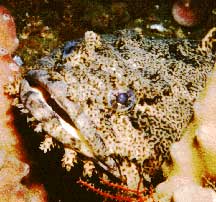
Toadfish is the common name for a variety of species from several different families of fish, usually because of their toad-like appearance. Dogfish is a name for certain species along the gulf coast.[ clarification needed ]

Toadfish is the common name for a variety of species from several different families of fish, usually because of their toad-like appearance. Dogfish is a name for certain species along the gulf coast.[ clarification needed ]
Toadfish make up a notable portion of the dolphin's diet, approximately 13%. Scientific experiments have shown that the mating call of the toadfish alerts dolphin predators to the fish's location. Similarly, the sounds caused by the dolphin when hunting its prey alert toadfish to the location of the predators and cause the fish to silence their mating call. Male toadfish will reduce their mating calls by up to 50% when they hear the low sound of a dolphin's "pop". [1]
The entire family Batrachoididae are called toadfishes. They are benthic ambush predators, known for their ability to produce sound with their swim bladders.

The name toadfish is applied to some species of the family Tetraodontidae, including:

The name toadfish is also applied to some species of the family Psychrolutidae:

Tetraodontidae is a family of primarily marine and estuarine fish of the order Tetraodontiformes. The family includes many familiar species variously called pufferfish, puffers, balloonfish, blowfish, blowers, blowies, bubblefish, globefish, swellfish, toadfish, toadies, toadle, honey toads, sugar toads, and sea squab. They are morphologically similar to the closely related porcupinefish, which have large external spines. The scientific name refers to the four large teeth, fused into an upper and lower plate, which are used for crushing the hard shells of crustaceans and mollusks, their natural prey.

Bottlenose dolphins are aquatic mammals in the genus Tursiops. They are common, cosmopolitan members of the family Delphinidae, the family of oceanic dolphins. Molecular studies show the genus contains three species: the common bottlenose dolphin, the Indo-Pacific bottlenose dolphin, and Tamanend's bottlenose dolphin. Others, like the Burrunan dolphin, may be alternately considered their own species or be subspecies of T. aduncus. Bottlenose dolphins inhabit warm and temperate seas worldwide, being found everywhere except for the Arctic and Antarctic Circle regions. Their name derives from the Latin tursio (dolphin) and truncatus for the truncated teeth.

The dusky dolphin is a dolphin found in coastal waters in the Southern Hemisphere. Its specific epithet is Latin for "dark" or "dim". It is very closely genetically related to the Pacific white-sided dolphin, but current scientific consensus holds they are distinct species. The dolphin's range is patchy, with major populations around South America, southwestern Africa, New Zealand, and various oceanic islands, with some sightings around southern Australia and Tasmania. The dusky dolphin prefers cool currents and inshore waters, but can also be found offshore. It feeds on a variety of fish and squid species and has flexible hunting tactics. The dusky dolphin is known for its remarkable acrobatics, having a number of aerial behaviours. The status of the dolphin is unknown, but it has been commonly caught in gill nets.

The false killer whale is a species of oceanic dolphin that is the only extant representative of the genus Pseudorca. It is found in oceans worldwide but mainly in tropical regions. It was first described in 1846 as a species of porpoise based on a skull, which was revised when the first carcasses were observed in 1861. The name "false killer whale" comes from having a skull similar to the orca, or killer whale.
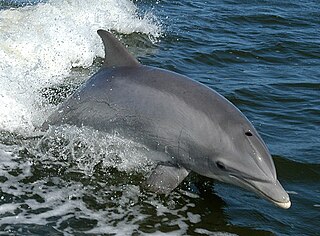
The common bottlenose dolphin or Atlantic bottlenose dolphin is one of three species of bottlenose dolphin in the genus Tursiops. The common bottlenose dolphin is a very familiar dolphin due to the wide exposure it receives in captivity in marine parks and dolphinariums, and in movies and television programs. Spending their entire life in water, common bottlenose dolphins inhabit temperate and tropical oceans throughout the world, absent only from polar waters. While formerly known simply as the bottlenose dolphin, this term is now applied to the genus Tursiops as a whole. As considerable genetic variation has been described within this species, even between neighboring populations, many experts think additional species may be recognized.
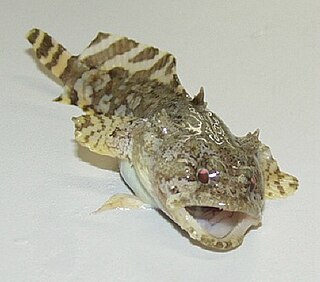
Batrachoididae is the only family in the ray-finned fish order Batrachoidiformes. Members of this family are usually called toadfish or frogfish: both the English common name and scientific name refer to their toad-like appearance.

The oyster toadfish, Opsanus tau, also known as the oyster toad, ugly toad, oyster cracker, oyster catcher, and bar dog, is a Northwest Atlantic species of fish of the family Batrachoididae. The maximum length of this toadfish is 43.2 cm (17 in), but they infrequently surpass 38 cm (15 in). The world record size for this species is 19.2 inches which is 48.76 cm. They are generally yellowish with a pattern of brown oblique bars. The species can live in poor conditions and needs little food to live. They can be found near the shore from Maine to Florida.

The red-tailed tropicbird is a seabird native to tropical parts of the Indian and Pacific Oceans. One of three closely related species of tropicbird (Phaethontidae), it was described by Pieter Boddaert in 1783. Superficially resembling a tern in appearance, it has almost all-white plumage with a black mask and a red bill. The sexes have similar plumage. As referenced in the common name, adults have red tail streamers that are about twice their body length. Four subspecies are recognised, but there is evidence of clinal variation in body size—with smaller birds in the north and larger in the south—and hence no grounds for subspecies.

A fish aggregatingdevice (FAD) is a man-made object used to attract pelagic fish such as marlin, tuna and mahi-mahi. They usually consist of buoys or floats tethered to the ocean floor. FADs attract fish for reasons that vary by species.

The bluefin gurnard or Pacific red gurnard is a species of marine ray-finned fishes belonging to the family Triglidae, the gurnards and sea robins. Its Māori names are kumukumu and pūwahaiau. It is found in the western Indian Ocean and the western Pacific Ocean, being common around Australia and New Zealand at depths down to 200 metres (660 ft). The fish is one of the most important commercial fish species in New Zealand.
The frilled toadfish is a fathead sculpin of the family Psychrolutidae, found on the continental shelf around Australia's Macquarie Island.
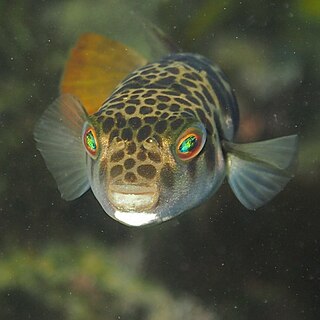
Tetractenos is a genus of Tetraodontidae. The genus can be found throughout the Indo-West Pacific and Australia's southern and eastern coastlines.

The colossal squid is the largest member of its family Cranchiidae, the cockatoo or glass squids, with its second largest member being Megalocranchia fisheri. It is sometimes called the Antarctic cranch squid or giant squid and is believed to be the largest squid species in terms of mass. It is the only recognized member of the genus Mesonychoteuthis and is known from only a small number of specimens. The species is confirmed to reach a mass of at least 495 kilograms (1,091 lb), though the largest specimens—known only from beaks found in sperm whale stomachs—may perhaps weigh as much as 600–700 kilograms (1,300–1,500 lb), making it the largest known invertebrate. Maximum total length has been estimated between 10 metres (33 ft) and 14 metres (46 ft) but the former estimate is more likely. The colossal squid has the largest eyes of any known creature ever to exist, with an estimated diameter of 27–30 cm (11–12 in).

The smooth toadfish is a species of fish in the pufferfish family Tetraodontidae. It is native to shallow coastal and estuarine waters of southeastern Australia, where it is widespread and abundant. French naturalist Christophe-Paulin de La Poix de Fréminville described the species in 1813, though early records confused it with its close relative, the common toadfish. The two are the only members of the genus Tetractenos after going through several taxonomic changes since discovery.
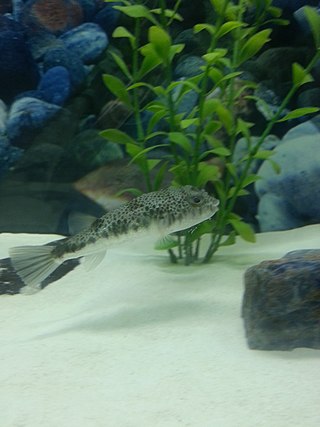
The common toadfish, also known as the common toado, toadfish or toado, is a species of fish in the family Tetraodontidae of order Tetraodontiformes, found along Australia's eastern coast, from northern Queensland to Flinders Island, and around Lord Howe Island, as well as in New Zealand waters. It often buries itself in sand with only its eyes exposed.

Toado is a common name for a variety of species of fish in the family Tetraodontidae, including:

A bait ball, or baitball, occurs when small fish swarm in a tightly packed spherical formation about a common centre. It is a last-ditch defensive measure adopted by small schooling fish when they are threatened by predators. Small schooling fish are eaten by many types of predators, and for this reason they are called bait fish or forage fish.

Ambophthalmos is a genus of marine ray-finned fish belonging to the family Psychrolutidae. These fishes are found in the southwestern Pacific Ocean.

Lagocephalus sceleratus, commonly known as the silver-cheeked toadfish, or Sennin-fugu, is an extremely poisonous marine bony fish in the family Tetraodontidae.

Batrachomoeus trispinosus, the three-spined frogfish or Broadbent's frogfish, is a species of Indo-Pacific toadfish, from the largely Old World subfamily, Halophryninae, of the family Batrachoididae. It is the type species of the genus Batrachomoeus. It is said to be the only fish known to cry like a baby and produce complex non-linear calls. Others fish can only make simple linear sounds but human babies and other mammals use non-linear sounds in their calls, in which other animals associate such non-linear sounds with a sense of emotional urgency.